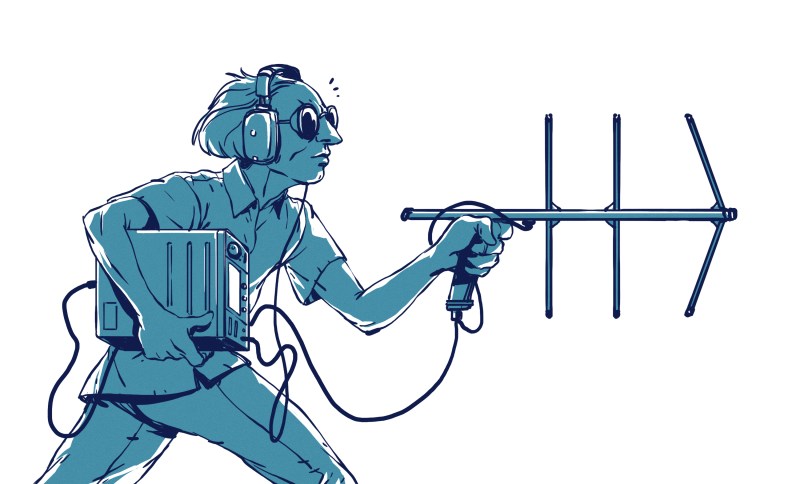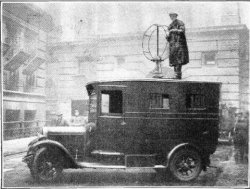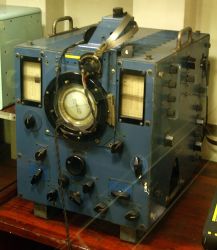
We think of radio navigation and direction finding as something fairly modern. However, it might surprise you that direction finding is nearly as old as radio itself. In 1888, Heinrich Hertz noted that signals were strongest when in one orientation of a loop antenna and weakest 90 degrees rotated. By 1900, experimenters noted dipoles exhibit similar behavior and it wasn’t long before antennas were made to rotate to either maximize signal or locate the transmitter.

Of course, there is one problem. You can’t actually tell which side of the antenna is pointing to the signal with a loop or a dipole. So if the antenna is pointing north, the signal might be to the north but it could also be to the south. Still, in some cases that’s enough information.
John Stone patented a system like this in 1901. Well-known radio experimenter Lee De Forest also had a novel system in 1904. These systems all suffered from a variety of issues. At shortwave frequencies, multipath propagation can confuse the receiver and while longwave signals need very large antennas. Most of the antennas moved, but some — like one by Marconi — used multiple elements and a switch.
However, there are special cases where these limitations are acceptable. For example, when Pan Am needed to navigate airplanes over the ocean in the 1930s, Hugo Leuteritz who had worked at RCA before Pan Am, used a loop antenna at the airport to locate a transmitter on the plane. Since you knew which side of the antenna the airplane must be on, the bidirectional detection wasn’t a problem.
Basic Navigation
Radio navigation owes a lot to ordinary celestial navigation and surveying. Instead of sighting a lighthouse, the sun, or a star, you sight a radio transmitter.

Consider you are in a field that has a flagpole on it and you know the exact location and height of the pole. If you are somewhere in the field and want to know where you are, you can use the pole. You sight the pole and measure the angle to the pole. Since you know the height and the angle, you can use geometry to draw a circle around the pole that you must be on.
Of course, you could be anywhere on the circle — what navigators call a line of position. But what if you had two poles? You could draw two circles. If you are lucky, the circles will touch at exactly one point and that is where you are. However, it is more common to have two points and — presumably — one will be very far away from where you ought to be and one will be close to where you should be.
Even with a simple pair of loops, you can do the same trick if they are far enough apart. If station one shows an angle of 30 degrees (or 210 degrees; it is ambiguous) to the transmitter and station two shows an angle of 300 degrees, you can triangulate by drawing two lines and noting where they cross.
Improvements

Even so, there was a demand for something better. In 1909 Ettore Bellini and Alessandro Tosi introduced an innovation. The Bellini-Tosi system used two antennas at right angles that fed coils. A third loop moved inside the coils to find the direction. This allowed the large antennas to remain stationary. By the 1920s these were quite common and remained so until the 1950s.
By 1919, the British engineer Frank Adcock came up with a system that used four vertical antennas, either monopoles or dipoles. This arrangement wired the antennas to effectively make a square loop that ignores horizontally polarized signals, thus reducing the reception of skywaves. Adcock antennas were often used with Bellini-Tosi detectors.
Lightning Strikes

In 1926, Brit Robert Watson-Watt was trying to detect lightning to help airmen and sailors avoid storms. Lightning signals are very fast, but it took about a minute for an experienced operator to line up a Bellini-Tosi detector. By coupling an Adcock antenna and an oscilloscope, Watt was able to rapidly lock onto a lightning bolt or a radio transmitter.
The military high-frequency direction finder or huff-duff proved invaluable during the war. The German U boats kept transmissions short to avoid detection, but with the huff-duff, that didn’t matter. The Germans didn’t figure out the technology improvement and estimates are that 25% of U boat sinking were due to the huff-duff.
Modern Times
Modern-day systems are much more sophisticated using phase locked loops and other techniques. Although some early systems like the one used by Pan Am used transmitters on the plane and receivers on the ground, most systems do the opposite. Older ADF — automatic direction finding — sets used motorized antennas to locate known transmitters. Modern sets use the Marconi system with multiple antennas, although the switch is electronic in this case.
Ham radio operators enjoy fox hunting — part of the event known as “radiosport” in most of the world — which is essentially hide and seek played with a radio transmitter. You can see more in the video below.
You might think that GPS has made radio direction finding a thing of the past. However, if you think about it, GPS is sort of a different form of radio direction finding. Instead of using a bearing of an antenna, you are measuring signal arrival time, but it is the same idea. The time delay gives you a circle from the known position of the satellite. Making multiple circles around multiple satellites gives you an exact position.
Sure, the technology is a far cry from Hertz’s loop antenna. But radio direction is still a key part of modern navigation systems.
0 Commentaires